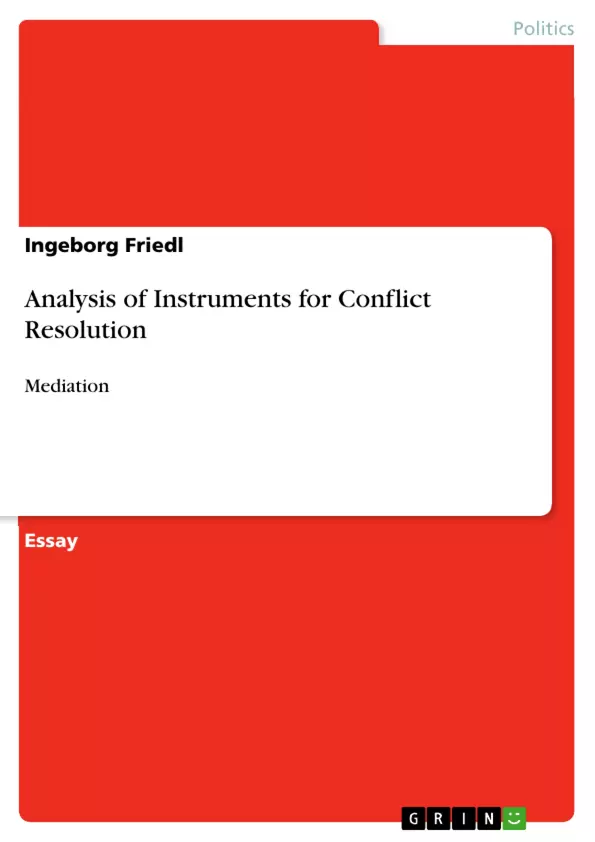In mediation the warring parties search for an acceptable solution under the aegis of a third party who is not party to the conflict and who enjoys the trust of the belligerents. As such he/she is a full partner in the negotiations, which means drawing up the agenda, organising and chairing meetings, proposing solutions and – where the mediator represents a powerful state – employing rewards or sanctions towards
the rivals. The success rate of mediation as a means for conflict resolution is mixed, which is why this topic deserves closer attention. This assignment discusses the effects of ripeness, (im)partiality, non state versus state, multiparty, facilitative and coercive mediation.
Inhaltsverzeichnis (Table of Contents)
- INTRODUCTION
- MEDIATION IN ARMED CONFLICT
- CONDITIONS CONDUCIVE TO MEDIATION SUCCESS/FAILURE
- Ripeness
- Neutrality versus partiality
- Power in conflict mediation
Zielsetzung und Themenschwerpunkte (Objectives and Key Themes)
This assignment analyzes the effectiveness of mediation in resolving conflicts. The primary objective is to explore the conditions under which mediation can be a successful tool for conflict resolution, while also addressing potential pitfalls and drawbacks. The paper aims to provide a comprehensive overview of the topic, drawing upon relevant research and examples.
- The effectiveness of mediation in different conflict situations
- The importance of ripeness, neutrality, and power dynamics in mediation
- The role of mediators in facilitating communication and negotiation
- The potential benefits and challenges of mediation in armed conflicts
- The relationship between mediation and coercive or non-coercive measures
Zusammenfassung der Kapitel (Chapter Summaries)
The first section examines the diverse types of conflict situations in which mediation can be an effective instrument for resolution. It highlights mediation's role in resolving deep-seated disputes, particularly those marked by long-standing animosity and seemingly intractable positions. This section emphasizes the potential of mediation in scenarios where parties deeply distrust each other, face cultural barriers, or refuse to acknowledge the other's legitimacy. The section also discusses the debate around the effectiveness of mediation based on the intensity of the conflict.
The second section dives into key conditions that influence the success or failure of mediation. This section delves into the concept of ripeness, arguing that mediation is most successful when the conflict parties have reached a stalemate, also known as a Mutually Hurting Stalemate (MHS). The section examines the debate surrounding mediator neutrality versus partiality, exploring arguments for and against each approach. Lastly, it investigates the influence of power in mediation, discussing the effectiveness of mediators from different power levels, such as small states, NGOs, powerful states, and international organizations.
Schlüsselwörter (Keywords)
This paper explores key concepts in conflict resolution, focusing on mediation as a tool for resolving disputes. Core terms include: mediation, armed conflict, conflict resolution, ripeness, neutrality, partiality, power dynamics, Mutually Hurting Stalemate (MHS), and third-party intervention. The paper examines the effectiveness of mediation in different conflict settings and explores the conditions that influence its success or failure.
- Quote paper
- Ingeborg Friedl (Author), 2009, Analysis of Instruments for Conflict Resolution, Munich, GRIN Verlag, https://www.grin.com/document/162661



